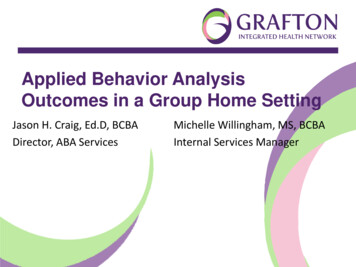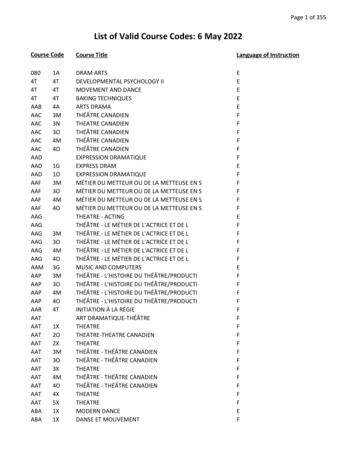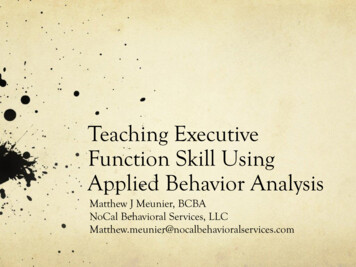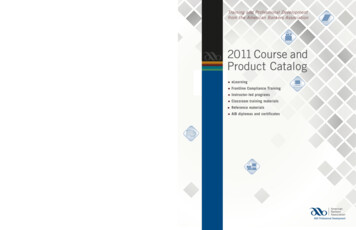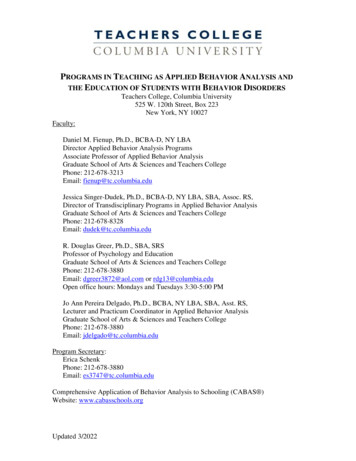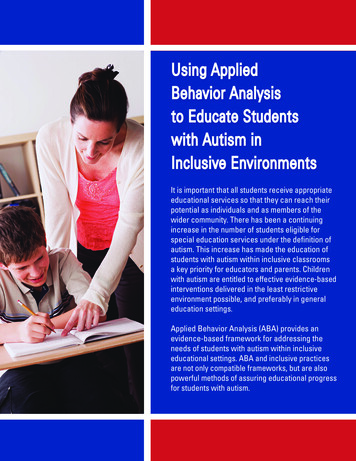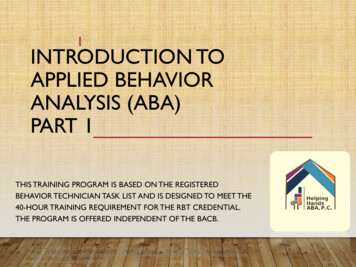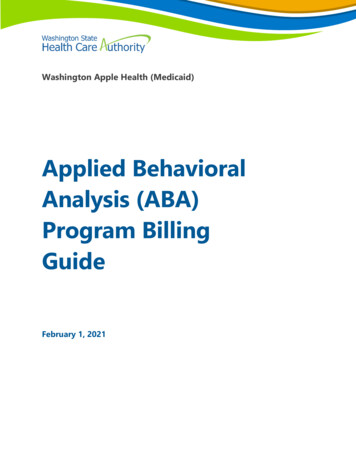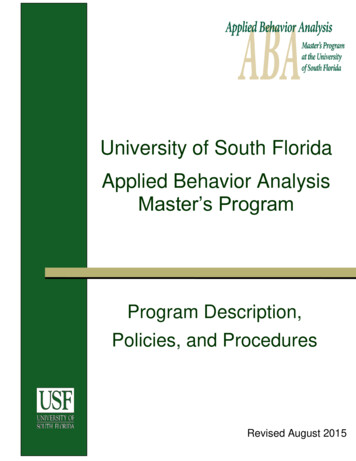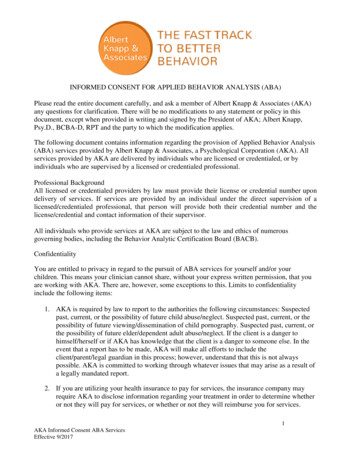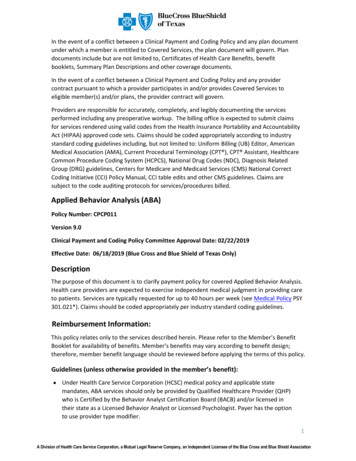
Transcription
In the event of a conflict between a Clinical Payment and Coding Policy and any plan documentunder which a member is entitled to Covered Services, the plan document will govern. Plandocuments include but are not limited to, Certificates of Health Care Benefits, benefitbooklets, Summary Plan Descriptions and other coverage documents.In the event of a conflict between a Clinical Payment and Coding Policy and any providercontract pursuant to which a provider participates in and/or provides Covered Services toeligible member(s) and/or plans, the provider contract will govern.Providers are responsible for accurately, completely, and legibly documenting the servicesperformed including any preoperative workup. The billing office is expected to submit claimsfor services rendered using valid codes from the Health Insurance Portability and AccountabilityAct (HIPAA) approved code sets. Claims should be coded appropriately according to industrystandard coding guidelines including, but not limited to: Uniform Billing (UB) Editor, AmericanMedical Association (AMA), Current Procedural Terminology (CPT ), CPT Assistant, HealthcareCommon Procedure Coding System (HCPCS), National Drug Codes (NDC), Diagnosis RelatedGroup (DRG) guidelines, Centers for Medicare and Medicaid Services (CMS) National CorrectCoding Initiative (CCI) Policy Manual, CCI table edits and other CMS guidelines. Claims aresubject to the code auditing protocols for services/procedures billed.Applied Behavior Analysis (ABA)Policy Number: CPCP011Version 9.0Clinical Payment and Coding Policy Committee Approval Date: 02/22/2019Effective Date: 06/18/2019 (Blue Cross and Blue Shield of Texas Only)DescriptionThe purpose of this document is to clarify payment policy for covered Applied Behavior Analysis.Health care providers are expected to exercise independent medical judgment in providing careto patients. Services are typically requested for up to 40 hours per week (see Medical Policy PSY301.021*). Claims should be coded appropriately per industry standard coding guidelines.Reimbursement Information:This policy relates only to the services described herein. Please refer to the Member’s BenefitBooklet for availability of benefits. Member’s benefits may vary according to benefit design;therefore, member benefit language should be reviewed before applying the terms of this policy.Guidelines (unless otherwise provided in the member’s benefit): Under Health Care Service Corporation (HCSC) medical policy and applicable statemandates, ABA services should only be provided by Qualified Healthcare Provider (QHP)who is Certified by the Behavior Analyst Certification Board (BACB) and/or licensed intheir state as a Licensed Behavior Analyst or Licensed Psychologist. Payer has the optionto use provider type modifier.1A Division of Health Care Service Corporation, a Mutual Legal Reserve Company, an Independent Licensee of the Blue Cross and Blue Shield Association
With the assistance of two or moretechnicians;Guidelines (unless otherwise provided in the member’s benefit), cont'd: ABA services are not to be educational, custodial or vocational in nature. Further, ABAservices are not to be provided in non-conventional, recreational, camp, vocational oracademic settings. Members are encouraged to seek out Individual Education Plan (IEP)services, as such services in academic settings are covered under the federal IDEA and FAPELaws (Individuals with Disabilities Education Act and Free Appropriate Public Education undersection 504). Educational and vocational items and services are funded directly or indirectly bya Federal, state or local entity, benefits may be excluded, and payment not made. Approval for payment is only applicable to empirically supported interventions for a current(within 36 months) Autism Spectrum Disorder diagnosis (see Medical Policy PSY 301.021*). The preparation of treatment plans/evaluations (inclusive of time for administration, scoring,interpretation and report write up) should generally be completed within 8 hours (32 units of97151). Documentation of any units billed beyond that may be subject to medical necessityreview and should justify the additional units. CPT code 97151 cannot be reportedconcurrently with other codes (AMA CPT Coding committee, 2018). Parent education is authorized per week for the authorization period (typically 26 weeks) fora total of 26 hours. Requests greater than one hour per week may be reviewed for medicalnecessity. Please refer to the most current release of the Centers for Medicare & Medicaid Services(CMS) Medically Unlikely Edits (MUE) table for guidance on the maximum units of servicethat a provider would report under most circumstances for a single beneficiary on a singledate of service. Service units are also limited by specific authorization period. CPT Codes 0362T, 0373T involve assessment and direct treatment of severe maladaptivebehavior and must be: Administered by the physician or other qualified healthcare professional who is on-site;With the assistance of two or more technicians;For a patient who exhibits destructive behavior;Completed in an environment that is customized, to the patient’s behavior.Examples of customized, specialized and high-intensity settings include a means of separatingfrom other patients, use of protective gear, padded isolation rooms with observationwindows and medical protocols for monitoring patient during and after high intensityepisodes an internal/external review board to examine adverse incidents, access tomechanical/chemical restraint, and frequent external review to determine if the patientneeds a higher level of care and whether this patient be safely treated in an outpatientsetting. This service may be provided in day treatment, intensive outpatient day treatment orinpatient facilities, depending on the behavior. These services are not reimbursable, soproviders should bill for encounter data purposes only. CPT code 97156 (Family Adaptive Behavior Treatment Guidance) is expressly for the QHP tomeet face to face with the guardians/caregivers of the patient (with or without the patientpresent). This code should be reported when engaging in this activity rather than 97155,which is reserved for meetings with the patient.2
Guidelines (unless otherwise provided in the member’s benefit), cont'd: CPT codes are face to face and with one patient unless otherwise specified in thedescription. Billable supervision of a patient must be face to face and involves only onetechnician. There is no CPT code for indirect (patient not present) supervision activities(other than report writing- 97151 and family adaptive behavior treatment guidance- 97156). Documentation required to substantiate that services were rendered include but are notlimited to: (1) a parent or caregiver’s signature for each rendered service that also includesthe service/code provided, rendering provider’s name/signature, the date of service, and thebeginning/end times of the service, (2) a written account, summary, or note of the servicerendered, and (3) data point(s) regarding the Member’s progress for the day. Case supervision activities are comprised of both direct supervision (patient present) andindirect supervision (patient not present). Direct supervision includes direction of RegisteredBehavior Technicians, treatment planning/monitoring fidelity of implementation, andprotocol modification. Whereas indirect supervision includes developing treatment goals,summarizing and analyzing data, coordination of care with other professionals, reportprogress toward treatment goals, develop and oversee transition/discharge plan, andtraining and directing staff on implementation of new/revised treatment protocols (patientnot present). The AMA codes for Adaptive Behavior Services indicate that the activitiesassociated with indirect supervision are bundled codes and are otherwise considered apractice expense and not reimbursable. Although indirect supervision is a practice expense,documentation in the treatment plan of this service occurring is expected. The BACB (2014,pp. 31) recommends 20% of direct hours be spent in “Case Supervision activities” [bothindirect and direct supervision combined] and 50% of this time be used for directsupervision. Direct supervision will be authorized at a 1:10 ratio or a minimum of 1 hourper week when less than 10 hours of direct services are authorized. Direct treatment by QHP (97152, 97153 or 97154). If the QHP “personally performs thetechnician activities, his or her time engaged in these activities should be reported astechnician time.” (AMA CPT Coding committee, 2018 pp 711). CPT codes 97154 and 97158 refer to group interventions. Groups must contain no less than 2members and no more than 8 members (AMA CPT Coding Committee, 2018. Use a single modifier to indicate the level of education, training, and certification of therendering provider of the 97153 codes.Reporting units for timed codes: When multiple units of therapies or modalities areprovided, the 8-minute rule must be followed when billing for these services. A provider shouldnot report a direct treatment service if only one attended modality or therapeutic procedure isprovided in a day and the procedure is performed for less than 8 minutes. The time reported should be the time actually spent in the delivery of the modality and/ortherapeutic procedure. This means that pre and post-delivery services should not be countedin determining the treatment time. The time that the patient spends not being treated, due to resting periods or waiting for apiece of equipment to become available, is not considered treatment time.3
Guidelines (unless otherwise provided in the member’s benefit), cont'd: All treatment time, including the beginning and ending time of the direct treatment, mustbe recorded in the patient’s medical record, along with the note describing the specificmodality or procedure.The following unit of service billing guideline has been published by Medicare. It is thestandard when billing multiple units of service with timed procedures defined as per each 15minutes. unit: 8 minutes through 22 minutes units: 23 minutes through 37 minutes units: 38 minutes through 52 minutes units: 53 minutes through 67 minutes units: 68 minutes through 82 minutes units: 83 minutes through 97 minutes units: 98 minutes through 112 minutes units: 113 minutes through 127 minutesIf any 15-minute timed service that is performed for 7 minutes or less on the same day asanother 15-minute timed service that was also performed for 7 minutes or less and the totaltime of the two is 8 minutes or greater, then bill one unit for the service performed for themost minutes. The same logic is applied when three or more different services are provided for7 minutes or less.For example, if a provider renders: 5 minutes of 97035 (ultrasound), 6 minutes of 97110 (therapeutic procedure), and 7 minutes of 97140 (manual therapy techniques)Then claim should be filed with 1 unit of 97140 since the total minutes of direct treatment is 18minutes. The patient’s medical record should document that all three modalities andprocedures were rendered and include the direct treatment time for each.If any direct patient contact timed service is performed on the same day as another directpatient contact timed service, then the total units billed cannot exceed the total treatment timefor these services.For example, if a provider renders: 8 minutes of 97530 (therapeutic activities), 8 minutes of 97110 (therapeutic procedure), and 8 minutes of 97140 (manual therapy techniques)Then claim should be filed with a total of 2 units since the total minutes of direct treatment is24 minutes. The patient’s medical record should document that all three modalities andprocedures were rendered and include the direct treatment time for each.Applied Behavior Analysis and Telehealth SupervisionNOTE: To pursue approval/authorization for ABA Telehealth supervision, the memberMUST have: 1) telehealth benefit coverage; and 2) have ABA benefit coverage, thensubsequently be approved for ABA treatment as medically necessary.4
DefinitionsThe American Telemedicine Association (2018) offers the following definitions:[Telemedicine is]- the use of medical information exchanged from one site to another viaelectronic communications to improve patients’ health status. Closely associated withtelemedicine is the term “telehealth”, which is often used to encompass a broader definition ofremote healthcare that does not always involve clinical services. Videoconferencing,transmission of still images, e-health including patient portals, remote monitoring of vital signs,continuing medical education and nursing call centers are all considered part of telemedicineand telehealth.Distance Site – A site where a health care provider who provides health care services arelocated while providing these services via a telecommunications system (i.e., QHP location).Origination Site – A site where a patient is located at the time health care services are providedvia a telecommunications system or service (i.e., location of the ABA services being conducted;in a practitioner office, or in a home setting with the client and direct therapist present).Synchronous – A real-time interaction between a patient, direct therapist, and QHP located at adistant site.BackgroundThe focus of Applied Behavior Analysis (ABA) treatment services relies on the use of‘observation’ to measure changes for a client in skills to improve their functioning. The BehaviorAnalyst Certification Board (BACB) States “ABA is a well-developed scientific discipline amongthe helping professions that focuses on the analysis, design, implementation, and evaluation ofsocial and other environmental modifications to produce meaningful changes in humanbehavior. ABA includes the use of direct observation, measurement, and functional analysis ofthe relations between environment and behavior. ABA uses changes in environmental events,including antecedent stimuli and consequences, to produce practical and significant changes inbehavior.” Therefore, the optimal and standard setting for conducting assessment and ABAservices is ‘face to face’.The member would be seen face to face at a minimum of 4 times per year at approximately 3month intervals. (This will include the functional assessments at 6-month periods to be face toface meetings.) There may be unique situations/circumstances where a member meets medicalnecessity for services, but due to geographic access reasons, the services are not available. Inthose unique situations, other options may be considered if all criteria outlined are met.Telehealth Medical Necessity - Addendum to ABA Clinical Form SubmissionBlue Cross Blue Shield (BCBS) members may be eligible for telehealth services only if: 1) theyreside and will receive services from an originating site located in a rural Health ProfessionalShortage Area (HPSA) located in a rural census tract or 2) the provider/agency submits toBCBS documentation the distance between the facility/clinic location to the eligiblerecipient’s location is at least 60 miles one-way (New Mexico Human Services Department,2014).Note: If the road a QHP travels to access the location of the eligible recipient or memberposes safety issues (dangerous winds/blowing dust, snowy or icy conditions) and thereare challenges to accessing emergency services, flexibility may be given to the 60 milesone-way allowance. The QHP must describe this situation in the eligible recipient’s ormember’s clinical file.5
Background, cont'dCase supervision must increase at least by a half-hour and up to 1 hour. This allows the QHPto have additional time to discuss and plan with the Behavior Technician/Direct Therapist theimplementation of the ABA Treatment Plan protocols. Telehealth supervision will require, at aminimum, a face to face functional assessment of the member by the QHP every 6 months,preferably prior to the approaching new authorization period.The QHP must document in the eligible recipient’s or member’s file that without the use oftelehealth technology the eligible recipient or member could not access medically necessaryABA services.Provider will need to complete the ABA Supervision Via Telehealth Request & Attestationform, obtained on the BCBS website, and send it in to review for this type of request.Note:1) Telehealth Supervision services at no time are simply utilized for the ‘convenience’ ofthe provider. It must be for the medical necessity of the member and their healthneeds.2) At a date in the future, if a QHP is available for the member to access in theirgeographic area, then the telehealth request can be revisited.3) Specific to approving ABA services utilizing telehealth services for supervision, thereare additional telehealth setup standards that would need to be met which areoutlined below.Telehealth Professional Setup and StandardsThe American Telemedicine Association (ATA) has set up recognized guidelines for effectiveand safe telehealth services. The expectation is a provider requesting to do supervision viatelehealth will be meeting these guidelines in these topic areas:1) State/federal legislation, regulations, accreditation and ethical standards for thetelehealth service.2) Provider must meet all the telehealth requirements for the state where the memberresides.3) Provider must meet all state (where member resides) and national requirements toprovide supervision for ABA services.4) Ensuring privacy and confidentiality (HIPAA) standards are being meet with theelectronic transmission method.5) Ensuring patients and health professionals are aware of their rights andresponsibilities with respect to utilizing this service.6) Availability of high quality cameras (video and/or still as clinically appropriate for theintended application), audio, and related data capture and transmission equipmentthat is appropriate for the telehealth clinical encounter, and which meet anyexisting practice-specific guidelines. Devices shall have up-to-date security softwareper the manufacturer’s recommendations. Health professionals/organizationsshould use device management software to provide consistent oversight ofapplications, device and data configuration and security.7) Real time interactive connectivity provides one-way or two-way live video servicesthrough consumer devices that use internet-based video conferencing softwareprograms6
Telehealth Supervision Authorization Approval Guidelines Telehealth supervision will require, at a minimum, a face to face functional assessmentof the member by the QHP every 6 months, prior to the approaching new authorizationperiod.Additionally, the member will be seen face to face at a minimum of 4 times per year atapproximately 3-month intervals. (This will include the functional assessments at 6month periods to be face to face meetings.)Indirect Services such as treatment planning, report writing, assessment and analysis ofdata, by QHP are bundled with 97151. If the QHP is directing the technician without theclient present this is also bundled service and not billable.ABA supervision via telehealth will require an active authorization on file for thesubmitted dates of service for the claim to be paid.Submit claims for telehealth ABA supervision services using the appropriate ABA CPTcodes (97155 or 97156 only) and a 95 modifier (Via a synchronous interactive audio andvideo telecommunications system)Submit claims for telehealth services using Place of Service (POS) 02: Telehealth: Thelocation where health services and health related services are provided or received,through telehealth telecommunication technology.Member’s policy must contain a telehealth as a covered benefit.For additional information on Telemedicine Medical Services and Telehealth Services guidelines,refer to the applicable state plan’s website and/or the states legislation, regulations.The following procedural codes serve as guidelines for the billing of Applied BehaviorAnalysis services:CPT 1569715797158BHV ID SUPRT ASSMT EA 15 MINADAPT BHV TX EA 15 MINBHV ID ASSMT BY PHYS/QHPBHV ID SUPRT ASSMT BY 1 TECHADAPTIVE BEHAVIOR TX BY TECHGRP ADAPT BHV TX BY TECHADAPT BEHAVIOR TX PHYS/QHPFAM ADAPT BHV TX GDN PHY/QHPMULT FAM ADAPT BHV TX GDNGRP ADAPT BHV TX BY PHY/QHP*References: Medical PoliciesTitlePolicy NumberApplied Behavior Analysis (ABA) PSY301.0217
References:1. American Medical Association CPT Coding Committee (2018). 2019 CPT ProfessionalCodebook. Chicago, Il: American Medical Association Publishing2. American Telemedicine Association (2018). Glossary of Terms: Telehealth and Telemedicine.Retrieved from emedicine-glossary3. American Psychiatric Association. (2013). Diagnostic and statistical manual of mentaldisorders, (5th Ed.). Arlington, VA: American Psychiatric Publishing.4. Behavior Analyst Certification Board (2014). Applied Behavior Analysis Treatment for AutismSpectrum Disorders: Guidelines for Healthcare Funders and Managers. Littleton, CO: Author.Available at http://bacb.com/asd-practice-document/5. Centers for Medicare & Medicaid Services (CMS) Medically Unlikely Edits (MUE) table(effective 1/1/2019). Available at tCodInitEd/MUE.html (accessed 2018 April 11).6. Fein, D., et al. (2013) Optimal Outcome in Individuals with a History of Autism. J ChildPsychol Psychiatry. Feb; 54(2): 195–205.7. New Mexico Human Services Department (2014). State of New Mexico. MedicalAssistanceProgram Medical Assistance Division Billing Instructions. Retrieved from ets.aspx8. Maglione M.A., et al. (2012) Technical Expert Panel; HRSA Autism Intervention Research –Behavioral (AIR-B) Network. Nonmedical interventions for children with ASD: recommendedguidelines and further research needs. Pediatrics. Nov;130 Suppl 2:S169-78.9. Ontario Association for Behaviour Analysis (2017). Evidenced Based Practices for Individualswith Autism Spectrum Disorder: Recommendations for Care Givers, Practitioners and PolicyMakers Ontario, Canada, Available at ORT%20WEB.pdf10. Orinstein A. J., et al., (2014) Intervention for optimal outcome in children and adolescentswith a history of autism. J Dev Behav Pediatr. May;35(4):247-56.11. Reichow B. (2012) Overview of meta-analyses on early intensive behavioral intervention foryoung children with autism spectrum disorders. J Autism Dev Disord. Apr;42(4):512-20.12. Weinmann S., et al. (2009) Behavioural and skill-based early interventions in children withautism spectrum disorders. GMS Health Technol Assess. Jul 29;13. Weitlauf, A.S., et al. (2014) Therapies for Children with Autism Spectrum Disorder:Behavioral Interventions Update. Effective Healthcare Program Comparative EffectivenessReview #137 AHRQ Publication No. 14-EHCO36 [Internet] Agency for Healthcare Researchand Quality. Aug Accessed at -update/research/Policy Update History:Approval Date04/30/201802/22/2019DescriptionNew policyCoding updates8
The billing office is expected to submit claims for services rendered using valid codes from the Health Insurance Portability and Accountability Act (HIPAA) approved code sets. Claims should be coded appropriately according to industry . Applied Behavior Analysis (ABA) Policy Number: CPCP011 . Version 9.0 .
